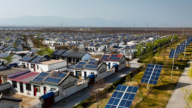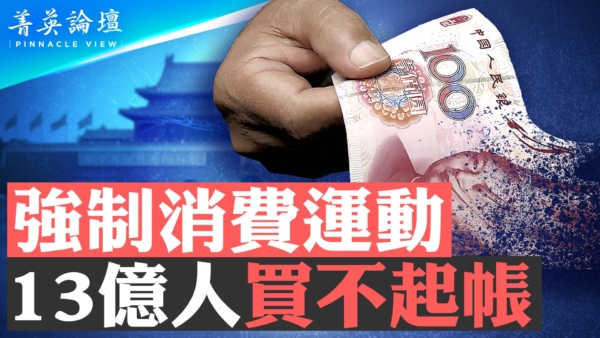【新唐人2013年04月08日讯】“债务风险”是近年来国际经济中最受关注的热点话题之一。日前,在博鳌亚洲论坛上,有几位业界专家指出,中国大陆极有可能成为下一波债务危机的爆发点。一起来听听他们的分析。
4月6号,在博鳌亚洲论坛名为“债务风险:下一个爆发点”的分组论坛上,包括多名经济学家在内的与会嘉宾,参加了关于欧债危机前景、美日债务风险分析、新兴经济体债务风险评估,和隐性负债风险的讨论,并探讨了可能危及全球经济复苏的下一个债务危机爆发点。
中国日益庞大的政府债务规模,自然是经济学者们讨论的中心。不过中共当局部门债务历来依靠民间统计,官方从来没有发布过准确数据。大陆《财经》杂志的最新分析统计显示,2012年政府部门债务,大约在30.8万亿元至33.8万亿元左右,相当于GDP的59.34%至65.12%。
“财新传媒”总发行人兼总编胡舒立,在论坛上发表演讲时直接指出,中国地方政府债务问题存在很大的潜在危机,首先是债务情况不透明,每一个人都不相信统计数据的准确性,另外,增长方式粗放,运行效率低下。
中国金融智库研究员巩胜利:“它党的成本运行,比如中共中央那些宣传部、统战部、还有维稳办那些,政法委的运行的成本都没有公开过。在这样一个大前提之下,有些数据都根本没有办法得知。所以中国这个问题比较复杂、比较严峻。因为它很多一部分都没有公开,没见阳光。”
胡舒立还提到,地方债务以“影子银行”的方式在增长,是一个值得警惕的负面现象,潜在很大的危机。她把这称为“中国式次贷”。
这一观点得到了中国经济学家、“春华资本”董事长胡祖六的赞同。
胡祖六认为,目前中小企业发展阻碍重重,这和大陆的金融改革有关。中共政府同时扮演所有者和监管者这两个有冲突的角色,管的太多、太杂,造成了更多隐形的金融风险。说大陆成功跨越全球金融危机,是“危险又自欺欺人的幻觉”。
而原财政部部长项怀诚在参与论坛讨论时,虽然承认政府债务存在透明度问题,实际债务率可能比公开数据高,不过他估计债务占GDP比重仅在40%左右。由此,他得出结论:目前政府的债务并非当务之急,还没到“非常危险”的地步。
而美国“南卡罗莱纳大学”艾肯商学院教授谢田则认为,中共政府的债务有其特殊性,不能类比西方国家的政府债务。
美国南卡罗莱纳大学艾肯商学院教授谢田:“在西方正常国家,地方政府的债务确实是一种公共债务,是政府为了公共基础设施而产生的债务。中国地方政府的债务大部分是投资在房地产,而这些房地产的拥有者全都是中共的权贵阶层,实际上不是说把这些钱用来发展公共设施和公众利益,而实际上是进入了贪官污吏的腰包。”
胡祖六还指出,目前,土地财政收入占地方财政收入的一半以上,这显然不可持续。为了解决财政压力,地方政府设立融资平台,以各种名目借债,导致债务规模失控,腐败横行。
胡祖六警示,下一个债务危机的爆发点极有可能在大陆。
中国金融智库研究员巩胜利:“它把党和政的运行成本都纳入到国家,这种运行成本是最高的。第二个方面,中国的企业运营成本高。因为中国现在是全球税收最高的国家之一。第三个就是企业生存困难,生存困难只有大量负债运营。从国有企业、中小企业再到中国公民生活成本高。这三个原因加在一起,如果长此以往不纠正,胡祖六说的这个现象其实早已经存在。”
另外,胡祖六还提到,要解决债务危机问题,中国应该向联邦制过渡,而不是中央集权。
采访/刘惠 编辑/李明飞 后制/陈建铭
Economy Specialists: China Might Be The Flash Point
Of The Next Global Debt Crisis
“Sovereign Debt Risk” is a focus of the international economy.
Recently, in “Boao Forum for Asia”, two economy specialists said
China is most likely the flash point of the next global debt crisis.
On April 6th a group discussion topic at “Boao Forum for Asia”
was “the next flask point of the global debt crisis”.
In the forum, participants discussed the prospects of European debt
crisis, debt risks of US and Japan, new debt risks hidden debt risks.
They also explored the next debt crisis,
which could endanger the recovery of the global economy.
However, the Chinese Communist party (CCP)
has never revealed any accurate debt figures.
Statistics on the debt are collated from non-governmental data.
The newest figures published by China’s magazine “Cai Jing” show
China’s sovereign debt went from 3.08 to 3.38 billion Chinese Yuan,
in 2012 which is equivalent from 59.34% to 65.12% of China’s GDP.
Hu Shuli, the main publisher and chief editor of “Cai Xin Media”,
said in the forum that China’s sovereign debt is a huge potential crisis.
Firstly, China’s debt situation is not transparent; the non-
governmental statistics are not accurate or reliable.
Secondly debt growth is operated very inefficiently.
Gong Shengli, researcher of China’s financial intelligence:
“The operation cost of the CCP has never been publicized.
We don’t know the annual costs to run Propaganda Department,
or the United Front Work Department.
We have no data for the Stability Maintenance Office and
Politics and Law Committee.
That data is not publicized and can never be obtained.
This makes the issues in China even more
complicated and challenging.”
Hu Shuli also said that China’s local government debt has been
increasing in the mode of the “shadow banking system”.
This phenomenon should be watched because it creates a substantial
secondary debt crisis. She called it “China-Mode Secondary Debt”.
Hu Shuli’s opinion was supported by Hu Zuli,
China’s economist and Director of Board of “Chun Hua Capital”.
Hu Zuliu stated there are a lot of obstacles for SME’s to survive
in China, which are related to the financial policy reforms.
The CCP acts as the owner and the supervision function
simultaneously. These two functions should really be separated.
This has caused more hidden financial risks.
When people say “China successfully survived the global
economy crisis”, they are only deceiving themselves with illusions.
Xiang Huaicheng, former Minister of Finance, admitted during
the discussion that China’s sovereign debt lacks transparency.
The actual debt amount can be more than the publicized amount.
Xiang’s estimation is China’s debt should be around 40% of its GDP.
His conclusion is China’s sovereign debt situation is not that risky.
Xie Tian, Professor of Aiken Business School
of University of South Carolina, stated that
unique characteristics of China’s sovereign debt make it
incomparable to the sovereign debts of western countries.
Xie Tian: “In a normal western country, government sovereign debt
is a public debt, which is used for the construction of public facilities.
However, China’s sovereign debt is invested in properties,
which are owned by China’s wealthy or powerful people.
Government debt in China is not used to develop public facilities
or public interests but flows into the wallets of corrupt officials.”
Hu Zuliu also said the income from properties
is about half the total local government income.
To solve the financial pressure, local governments
raise loans under various names.
Debt is spiraling out of control so is rampant corruption.
Hu Zuliu warned the next flash point of
global debt crisis is most likely in China.
Gong Shengli: ”Firstly, when operation cost of the CCP and political
needs costs are taken account into government cost, it’s prohibitive.
Secondly, business operational cost is very expensive because
China is one of the countries that charge the highest taxes.
Thirdly, it’s very difficult for businesses to survive in China
so they have to operate in debt.
The survival cost of national business, SME’s and
even China’s citizens is very high.
Those phenomena have existed for such a long time
but they haven’t been rectified yet.”
Hu Zuliu also thinks that to solve the issues of China’s
sovereign debt, China needs a federal system not centralized one.





























